- Cultural Landscapes of Japan
-
Landscapes which have evolved together with the way of life and geocultural features of a region, and which are indispensable for understanding the lifestyle of the Japanese people, are recognized by the government of Japan as Cultural Landscapes (文化的景観 bunkateki keikan) under article 2, paragraph 1, item 5 of the Law for the Protection of Cultural Properties (1950). Cultural Landscapes of especially high value may be further designated as Important Cultural Landscapes (重要文化的景観 Jūyō bunkateki keikan); as of April 2011 there are twenty-four such landscapes.[1][2]
Local governments that are in charge of designated Cultural Landscapes can obtain financial assistance from the Agency for Cultural Affairs for surveys and other research, the preparation of preservation plans, maintenance, repair, landscaping, restoration, disaster prevention, and promotional and educational activities.[1][3]
Contents
Background
Research into cultural landscapes began before the Second World War with increasing concern about their disappearance. Historical research into shōen and rural engineering, the scientific investigation of geographic features, and studies for urban and countryside planning have since increased. The movement to protect cultural landscapes has also been influenced by the Law Concerning Special Measures for the Preservation of Historical Natural Features in Ancient Cities (1966), the international trend for recognising 'cultural landscapes' under the World Heritage Convention, the designation in 1980 of Mount Hakusan, Mount Ōdaigahara & Mount Ōmine, Shiga Highland and Yakushima as UNESCO Man and the Biosphere Reserves, the designation of Monuments of Japan, and initiatives such as the 100 selected terraced rice fields of Japan.[4][5] From 2000 to 2003 a study was made to define the concept of 'cultural landscape' and identify their distribution, with 2,311 areas identified in the first phase and 502 selected for the second, 180 being of particular importance.[6]
Selection criteria of Important Cultural Landscapes
Important Cultural Landscapes are designated based on their type as:[1][7]
- single-type Cultural Landscapes associated with
- agriculture such as rice paddies, farmlands, etc.
- man-made grassland or livestock ranching such as hayfields, pastureland, etc.
- forests such as timber forests, disaster prevention forests, etc.
- fisheries such as fish cultivation rafts, nori seaweed cultivation fields, etc.
- water uses such as reservoirs, waterways, harbors, etc.
- mining or industrial manufacture such as mines, quarries, groups of workshops, etc.
- transportation and communication such as roads, plazas, etc.
- residences and settlements such as stonewalls, hedges, coppices attached to premises, etc.
- a combination of two or more of the above cultural landscapes.
List of Important Cultural Landscapes
Usage
An overview of what is included in the table and the manner of sorting is as follows: the columns (with the exceptions of Remarks and Pictures) are sortable by pressing the arrows symbols.
- Name: the English name as used by the Agency for Cultural Affairs[3] and Japanese name as registered in the Database of National Cultural Properties[2]
- Criteria: the selection criteria for the designation as Important Cultural Landscape
- Remarks: general remarks
- Location: "town-name prefecture-name"; The column entries sort as "prefecture-name town-name".
- Year: year of designation as Important Cultural Landscape
- Picture: picture of (part of) the Important Cultural Landscape
List
Name Criteria Remarks Location Year Picture Cultural Landscape along the Sarugawa River resulting from Ainu Tradition and Modern Settlement (アイヌの伝統と近代開拓による沙流川流域の文化的景観 ainu no dentō to kindai kaitaku ni yoru sarugawa ryūiki no bunkateki keikan)[8] 2 Litigation over the Nibutani Dam saw the advocacy of Ainu rights in a landmark case (1997).[9] Biratori, Hokkaidō 2007 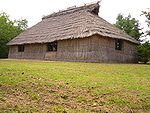
Farm Village of Hondera area, Ichinoseki (一関本寺の農村景観 ichinoseki hondera no nōson keikan)[10] 1.1, 1.8, 2 Administered from the late Heian period to the early Muromachi period as the domain of the Sutra Repository Steward of Chuson-ji;[11] in the Edo period it formed part of the Sendai domain.[12] Ichinoseki, Iwate 2006 Tono Arakawakōgen Farm (遠野 荒川高原牧場 Tōno Arakawakōgen bokujō)[13] 1.2 Important historic pasture.[14] Tōno, Iwate 2008/9 Cultural landscape in Kanazawa. Tradition and culture in the castle town (金沢の文化的景観 城下町の伝統と文化 Kanazawa no bunkateki keikan; jōkamachi no dentō to bunka)[15] 1.5, 1.7, 1.8 Kanazawa is a renowned centre of Japanese crafts.[16] Kanazawa, Ishikawa 2010 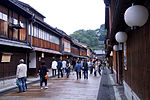
Rice terraces in Obasute (姨捨の棚田 Obasute no tanada)[17] 1.1 Chikuma, Nagano 2010 Wetland in Ōmi-hachiman (近江八幡の水郷 Ōmi Hachiman no suigō)[18] 1.5, 1.8 Riverside district of the former castle town.[19] Ōmihachiman, Shiga 2006 
Waterfront of Kaizu, Nishihama, and Chinai in Takashima City (高島市海津・西浜・知内の水辺景観 Takashima-shi Kaizu Nishihama Chinai no mizube keikan)[20] 1.5, 1.7 Takashima, Shiga 2008 Waterfront of Harie and Shimofuri in Takashima City (高島市針江・霜降の水辺景観 Takashima-shi Harie Shimofuri no mizube keikan)[21] Takashima, Shiga 2010 Cultural landscape in Uji (宇治の文化的景観 Uji no bunkateki keikan)[22] 2 Uji, Kyoto 2009 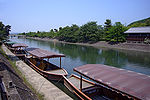
Rice terraces in Kashihara (樫原の棚田 Kashihara no tanada)[23] 1.1, 1.8 Kamikatsu, Tokushima 2010 Danbata (terraced fields) in Yusumizugaura (遊子水荷浦の段畑 Yusumizugaura no danbata)[24] 1.1 Uwajima, Ehime 2007 Kure port and fishing townscape (久礼の港と漁師町の景観 Kure no minato to ryōshi machi no keikan)[25] 1.4, 1.5 Tosa, Kōchi 2011 Cultural landscape in the Shimantogawa River basin. Villages in the mountains to the headwater region (四万十川流域の文化的景観 源流域の山村 Shimantogawa ryūiki no bunkateki keikan genryūiki no sanson)[26] 2 Tsuno, Kōchi 2009 Cultural landscape in the Shimantogawa River basin. Villages and rice terraces in the mountains at the upstream region (四万十川流域の文化的景観 上流域の山村と棚田 Shimantogawa ryūiki no bunkateki keikan jōryūiki no sanson to tanada)[27] 2 Yusuhara, Kōchi 2009 Cultural landscape in the Shimantogawa River basin. Circulation and traffic among agricultural and mountainous villages at the upstream region (四万十川流域の文化的景観 上流域の農山村と流通・往来 Shimantogawa ryūiki no bunkateki keikan jōryūiki no nōsanson to ryūtsū ōrai)[28] 2 Nakatosa, Kōchi 2009 Cultural landscape in the Shimantogawa River basin. Circulation and traffic among agricultural and mountainous villages at the middlestream region (四万十川流域の文化的景観 中流域の農山村と流通・往来 Shimantogawa ryūiki no bunkateki keikan chūryūiki no nōsanson to ryūtsū ōrai)[29] 2 Shimanto, Kōchi 2009 
Cultural landscape in the Shimantogawa River basin. Vocations, circulation and traffic in the downstream region (四万十川流域の文化的景観 下流域の生業と流通・往来 Shimantogawa ryūiki no bunkateki keikan karyūiki no nariwai to ryūtsū ōrai)[30] 2 Shimanto, Kōchi 2009 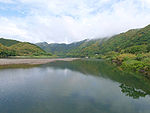
Terraced rice fields of Warabino (蕨野の棚田 Warabino no tanada)[31] 1.1 located on a north facing horseshoe shaped steep slope of Mount Hachiman (八幡岳 hachimandake); area: 34 ha (84 acres), average step height: 3–5 m (9.8–16 ft) (up to 8 m (26 ft) max) Karatsu, Saga 2008 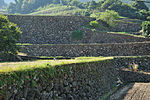
Cultural landscape of the Ojika islands (小値賀諸島の文化的景観 Ojikashotō no bunkateki keikan)[32] 1.7, 1.8 Ojika, Nagasaki 2011 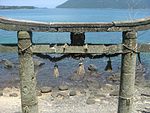
Cultural landscape in Hirado island (平戸島の文化的景観 Hiradoshima no bunkateki keikan)[33] 1.1, 1.5, 1.8 Hirado, Nagasaki 2010 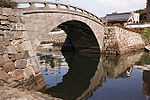
Landscape with Tsūjun irrigation channel and rice terraces in Shiraito Plateau (通潤用水と白糸台地の棚田景観 Tsūjun yōsui to Shiraito daichi no tanada keikan)[34] 1.1, 1.5, 2 The discharge of water from the Tsūjun Bridge is one of the 100 Soundscapes of Japan Yamato, Kumamoto 2008/9 
Fishing village of Sakitsu, Amakusa (天草市﨑津の漁村景観 Amakusa-shi sakitsu no gyoson keikan)[35] 1.4, 1.7, 1.8 Amakusa, Kumamoto 2011 Ontayaki Village (小鹿田焼の里 Ontayaki no sato)[36] 2 Hita, Ōita 2008 Rural landscape of Tashibunoshō Osaki (田染荘小崎の農村景観 Tashibunoshō Osaki no nōson keikan)[37] Bungotakada, Ōita 2010 This list is complete and up-to-date as of April 29, 2011.References
- ^ a b c "Our Treasure Cultural Landscapes to future generations" (PDF). Administration of Cultural Affairs in Japan ― Fiscal 2009. Agency for Cultural Affairs. 2009. http://www.bunka.go.jp/bunkazai/pamphlet/pdf/pamphlet_en_01.pdf.
- ^ a b The Agency for Cultural Affairs (2008-11-01). "国指定文化財 データベース" (in Japanese). Database of National Cultural Properties. http://www.bunka.go.jp/bsys/index.asp. Retrieved 2009-04-16.
- ^ a b "Preservation and Utilization of Cultural Properties - Cultural Lanscapes". Agency for Cultural Affairs. p. 39. http://www.bunka.go.jp/english/pdf/h21_chapter_06.pdf. Retrieved 18 April 2011.
- ^ "The Report of the Study on the Protection of Cultural Landscapes Associated with Agriculture, Forestry and Fisheries (2003)". Agency for Cultural Affairs. pp. 1ff., 33ff. http://www.bunka.go.jp/english/pdf/nourinsuisan.pdf. Retrieved 29 April 2011.
- ^ "UNESCO MAB Reserves - Asia". UNESCO. http://www.unesco.org/mab/doc/brs/apa.pdf. Retrieved 29 April 2011.
- ^ "The Report of the Study on the Protection of Cultural Landscapes Associated with Agriculture, Forestry and Fisheries (2003)". Agency for Cultural Affairs. pp. 21f., 26f., 66ff. http://www.bunka.go.jp/english/pdf/nourinsuisan.pdf. Retrieved 29 April 2011.
- ^ "The Report of the Study on the Protection of Cultural Landscapes Associated with Agriculture, Forestry and Fisheries (2003)". Agency for Cultural Affairs. pp. 25f. http://www.bunka.go.jp/english/pdf/nourinsuisan.pdf. Retrieved 29 April 2011.
- ^ "Database of Registered National Cultural Properties". Agency for Cultural Affairs. http://www.bunka.go.jp/bsys/maindetails.asp?register_id=412&item_id=00003550. Retrieved 29 April 2011.
- ^ Levin, Mark. "Kayano et al. v. Hokkaido Expropriation Committee: 'The Nibutani Dam Decision' (abstract)". Social Science Research Network. http://papers.ssrn.com/sol3/papers.cfm?abstract_id=1635447. Retrieved 29 April 2011.
- ^ "Database of Registered National Cultural Properties". Agency for Cultural Affairs. http://www.bunka.go.jp/bsys/maindetails.asp?register_id=412&item_id=00003491. Retrieved 29 April 2011.
- ^ "Honederamura Shoen Iseki". Iwate Prefecture. http://www.city.ichinoseki.iwate.jp/index.cfm/7,22660,113,html. Retrieved 18 April 2011.
- ^ "Hondera - history". Honederamura. http://www.honedera.jp/outline/history.html. Retrieved 18 April 2011.
- ^ "Database of Registered National Cultural Properties". Agency for Cultural Affairs. http://www.bunka.go.jp/bsys/maindetails.asp?register_id=412&item_id=00003587. Retrieved 29 April 2011.
- ^ "Arakawakōgen bokujō". Iwate Prefecture. http://www.bunka.pref.iwate.jp/ciss/bunkazai/detail/id/555. Retrieved 29 April 2011.
- ^ "Database of Registered National Cultural Properties". Agency for Cultural Affairs. http://www.bunka.go.jp/bsys/maindetails.asp?register_id=412&item_id=00003675. Retrieved 29 April 2011.
- ^ "About Kanazawa City". Kanazawa City. http://www.city.kanazawa.ishikawa.jp/guide_e/index.html. Retrieved 29 April 2011.
- ^ "Database of Registered National Cultural Properties". Agency for Cultural Affairs. http://www.bunka.go.jp/bsys/maindetails.asp?register_id=412&item_id=00003676. Retrieved 29 April 2011.
- ^ "Database of Registered National Cultural Properties". Agency for Cultural Affairs. http://www.bunka.go.jp/bsys/maindetails.asp?register_id=412&item_id=00003482. Retrieved 29 April 2011.
- ^ "Omihachiman no suigō". Ōmihachiman. http://www.city.omihachiman.shiga.jp/contents_detail.php?frmId=503. Retrieved 29 April 2011.
- ^ "Database of Registered National Cultural Properties". Agency for Cultural Affairs. http://www.bunka.go.jp/bsys/maindetails.asp?register_id=412&item_id=00003588. Retrieved 29 April 2011.
- ^ "Database of Registered National Cultural Properties". Agency for Cultural Affairs. http://www.bunka.go.jp/bsys/maindetails.asp?register_id=412&item_id=00003694. Retrieved 29 April 2011.
- ^ "Database of Registered National Cultural Properties". Agency for Cultural Affairs. http://www.bunka.go.jp/bsys/maindetails.asp?register_id=412&item_id=00003630. Retrieved 29 April 2011.
- ^ "Database of Registered National Cultural Properties". Agency for Cultural Affairs. http://www.bunka.go.jp/bsys/maindetails.asp?register_id=412&item_id=00003677. Retrieved 29 April 2011.
- ^ "Database of Registered National Cultural Properties". Agency for Cultural Affairs. http://www.bunka.go.jp/bsys/maindetails.asp?register_id=412&item_id=00003551. Retrieved 29 April 2011.
- ^ "Database of Registered National Cultural Properties". Agency for Cultural Affairs. http://www.bunka.go.jp/bsys/maindetails.asp?register_id=412&item_id=00003714. Retrieved 29 April 2011.
- ^ "Database of Registered National Cultural Properties". Agency for Cultural Affairs. http://www.bunka.go.jp/bsys/maindetails.asp?register_id=412&item_id=00003631. Retrieved 29 April 2011.
- ^ "Database of Registered National Cultural Properties". Agency for Cultural Affairs. http://www.bunka.go.jp/bsys/maindetails.asp?register_id=412&item_id=00003632. Retrieved 29 April 2011.
- ^ "Database of Registered National Cultural Properties". Agency for Cultural Affairs. http://www.bunka.go.jp/bsys/maindetails.asp?register_id=412&item_id=00003633. Retrieved 29 April 2011.
- ^ "Database of Registered National Cultural Properties". Agency for Cultural Affairs. http://www.bunka.go.jp/bsys/maindetails.asp?register_id=412&item_id=00003634. Retrieved 29 April 2011.
- ^ "Database of Registered National Cultural Properties". Agency for Cultural Affairs. http://www.bunka.go.jp/bsys/maindetails.asp?register_id=412&item_id=00003635. Retrieved 29 April 2011.
- ^ "Database of Registered National Cultural Properties". Agency for Cultural Affairs. http://www.bunka.go.jp/bsys/maindetails.asp?register_id=412&item_id=00003604. Retrieved 29 April 2011.
- ^ "Database of Registered National Cultural Properties". Agency for Cultural Affairs. http://www.bunka.go.jp/bsys/maindetails.asp?register_id=412&item_id=00003715. Retrieved 29 April 2011.
- ^ "Database of Registered National Cultural Properties". Agency for Cultural Affairs. http://www.bunka.go.jp/bsys/maindetails.asp?register_id=412&item_id=00003678. Retrieved 29 April 2011.
- ^ "Database of Registered National Cultural Properties". Agency for Cultural Affairs. http://www.bunka.go.jp/bsys/maindetails.asp?register_id=412&item_id=00003605. Retrieved 29 April 2011.
- ^ "Database of Registered National Cultural Properties". Agency for Cultural Affairs. http://www.bunka.go.jp/bsys/maindetails.asp?register_id=412&item_id=00003716. Retrieved 29 April 2011.
- ^ "Database of Registered National Cultural Properties". Agency for Cultural Affairs. http://www.bunka.go.jp/bsys/maindetails.asp?register_id=412&item_id=00003589. Retrieved 29 April 2011.
- ^ "Database of Registered National Cultural Properties". Agency for Cultural Affairs. http://www.bunka.go.jp/bsys/maindetails.asp?register_id=412&item_id=00003695. Retrieved 29 April 2011.
Further Reading
Nakagoshi, Nobukazu (2011). "How to Conserve Japanese Cultural Landscapes: The Registration System for Cultural Landscapes". In Sun-kee Hong. Landcape Ecology in Asian Cultures. Springer. pp. 249–276. ISBN 978-4-431-87798-1.
Cultural Properties of Japan Tangible Cultural Properties of Japan Designations/Registrations National Treasures of Japan · Important Cultural Properties of Japan · Registered Tangible Cultural Properties of JapanLists Lists of National Treasures of JapanIntangible Cultural Properties of Japan Designations Important Intangible Cultural Properties · Preservers of Important Intangible Cultural PropertiesLists List of Important Intangible Cultural Properties · List of Living National Treasures of Japan (crafts) · List of Living National Treasures of Japan (performing arts)Folk Cultural Properties of Japan Designations/Registrations Lists List of Important Tangible Folk Cultural Properties · List of Important Intangible Folk Cultural PropertiesMonuments of Japan Designations/Registrations Lists List of Special Places of Scenic Beauty, Special Historic Sites and Special Natural MonumentsCultural Landscapes of Japan Designations Important Cultural LandscapesLists List of Important Cultural LandscapesGroups of Traditional Buildings Designations Important Preservation Districts for Groups of Traditional Buildings · Preservation Districts for Groups of Traditional BuildingsLists List of Important Preservation Districts for Groups of Traditional BuildingsConservation Techniques for Cultural Properties Designations Selected Conservation TechniquesLists List of Selected Conservation TechniquesBuried Cultural Properties Categories:- Japanese culture
- Cultural landscapes
- single-type Cultural Landscapes associated with
Wikimedia Foundation. 2010.

